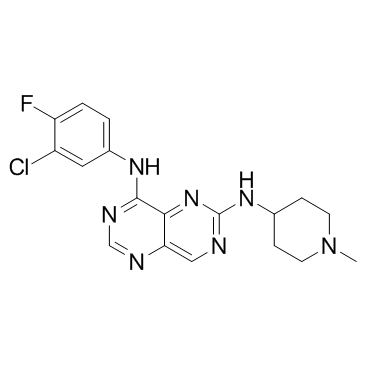196612-93-8
| Name | BIBX 1382 dihydrochloride,N8-(3-Chloro-4-fluorophenyl)-N2-(1-methyl-4-piperidinyl)-pyrimido[5,4-d]pyrimidine-2,8-diaminedihydrochloride |
|---|---|
| Synonyms |
Pyrimido[5,4-d]pyrimidine-2,8-diamine, N-(3-chloro-4-fluorophenyl)-N-(1-methyl-4-piperidinyl)-, hydrochloride (1:2)
N-(3-Chloro-4-fluorophenyl)-N-(1-methylpiperidin-4-yl)pyrimido[5,4-d]pyrimidine-2,8-diamine dihydrochloride N-(3-Chloro-4-fluorophenyl)-N-(1-methyl-4-piperidinyl)pyrimido[5,4-d]pyrimidine-2,8-diamine dihydrochloride BIBX 1382 |
| Description | Falnidamol (BIBX 1382) is a potent, selective inhibitor of EGFR tyrosine kinase (IC50 = 3 nM); displays > 1000-fold lower potency against ErbB2 (IC50 = 3.4 μM) and a range of other related tyrosine kinases (IC50 > 10 μM). |
|---|---|
| Related Catalog | |
| Target |
EGFR:3 nM (IC50) |
| In Vitro | Falnidamol (BIBX 1382) and BIBU1361 are both potent and selective submicromolar inhibitors of the EGFR kinase activity. An IC50 value of 3 nM was determined for both compounds. The potency of these two compounds compares with the one obtained with Iressa, which is a leading EGFR inhibitor in the field. Inhibition of the closest family member, HER2, was 100- to 1000-fold less potent. Furthermore, Falnidamol (BIBX 1382) and BIBU1361 did not inhibit a number of other related tyrosine kinases[1]. |
| In Vivo | In nude mice, oral once daily dosing at 10 mg/kg with either Falnidamol (BIBX 1382) or BIBU1361 completely suppressed tumor growth of human A431 xenografts with respective T/C values of 15 and 6% after 2 weeks of treatment[1]. |
| Animal Admin | Animal administration[1] Five- to six-week-old athymic NMRI-nu/nu female mice (21-31 g) were inoculated s.c. with 1 × 106 (in 100 μl) A431, FaDu, or HN5 cells into the right flank of the animal. After 7 to 11 days, tumors reached a average volume of 40 to 130 mm3. The mice were randomized and treated daily p.o. with Falnidamol (BIBX 1382), BIBU1361, or vehicle control on the basis of individual weights. Tumors were measured three times a week with calipers, and tumor volumes were calculated by the formula π/6 × length × (width)2. Experimental compounds were prepared in 25% aqueous hydroxypropyl-β-cyclodextrin and administered by intragastral gavage. The administration volume was 10 ml/kg b.wt. |
| References |
| Boiling Point | 594ºC at 760mmHg |
|---|---|
| Molecular Formula | C18H19ClFN7 |
| Molecular Weight | 387.84 |
| Flash Point | 313.1ºC |
| PSA | 78.86000 |
| LogP | 5.14990 |
| Vapour Pressure | 3.15E-12mmHg at 25°C |
| Index of Refraction | 1.7 |
| Storage condition | -20℃ |
